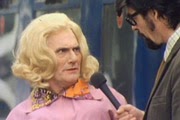 |
| My reconstruction of the 'Erment Model' |
Just how one could make an alternative trireme is a bit of a puzzle but not beyond ingenuity. We have today the advantage of having seen a working trieres in the form of Olympias (2) and must admit that this colours our vision. Notwithstanding this, there are still critics such as Alec Tilley(3) who have alternative suggestions for how a trieres could be constructed on other lines.
 |
| The '3' is here three men sitting side-by-side |
 |
| Tilley would have the oarsmen on the same level - ergo Erment cannot be a trieres |
After Brasch the Erment model is seen as supporting a version of the trieres which is first seen on the Sennacherib stela from Nineveh and that show the flight of Luli from Sidon.
 |
| Nineveh stela c.701.bc. |
In 1975 Alan Lloyd(4) pretty much knocked the 'Phoenician trieres' theory into touch with his thorough-going rebuttal of Brasch's paper. It includes a quote from R.C. Anderson's 1962 paper(5) which is rather damning. viz.
'It may be made for a trireme, but there is nothing whatever to be learnt from it.'
Subsequently, an expert on specifically Egyptian Hellenistic terracottas remarked (6)
'Technically Græco-Egyptian terracottas are clumsy work, made with few moulds and the minimum of effort.'
Lloyd's conclusion/broadside...
'M.Brasch may well be right in claiming that the craftsman had in mind a Phoenician trireme but it seems hazardous in the extreme to use such an object to prove that the ship did not possess a parexeiresia, was not equipped with wales - neither of which occur on Egyptian ships and may well have fallen outside the potter's experience - and had a hull whose proportions differed fundamentally from its Greek counterpart.'
 |
| Erment/Phoenicia to the left,: Olympias/Greece to the right |
 |
| Straight.sided penteres(removing hanging oarbox |
As any clay structure is built up it tends to sag under its own weight. One can avoid this by a) avoiding overhangs and b) ensuring all points are supported from beneath c) making the structure lighter in the top.
I think the Erment model has its final shape because of these factors. The original profile of a trieres is almost impossible to make in a model of this size if one is not going to take time-consuming steps to support it and let it dry progressively as one builds.
 |
| Looks Ementish but WRONG. From Napoleon III's reconstruction of 1882 by Admiral Serre. A classic failure. |
 |
| Still wrong profile - perfectly round is BAD (puking imminent) |
 |
| Profile of Olympias by John Coates. Too broad for a clay model. |
I also think the Erment model does have an outrigger but it is misunderstood by the maker. AND transformed so that it fits with the clay's characteristics.
 |
| Instead of the oar tiers being set further outboard as in the real thing, the model has them set over each other for the sake of constructing something easily from clay. |
 |
| The parexeiresia is beneath the upper oars but squished inboard |
The ship's profile is explained by these factors also. It is flat-bottomed because it must stand solidly as it is built. It is high and stright-sided because an open, low form will collapse unless a time-consuming process is adopted for construction.
I would say the modeller wanted to give a good impression of a trieres and he does. It is a slim, sleek ship with many oars. It has a fierce prominent ram and efficient prominent pedalia which look like they can really affect the ship's progress.
 |
| Version 2 may be painted to look a little less like Sonic the Hedgehog! |
It's awful, but I like it.....
(Ref.list to follow)


No comments:
Post a Comment